Ray-Finned Fish
This page was born
12/02/2009. Rickubis designed it. (such as it is.)
Last update: 11/29/2024
Images and contents on
this page copyright ©2002-2024 Richard M. Dashnau
Go back to my home page, Welcome
to rickubis.com
Go back
to the RICKUBISCAM page.
Fish
are
also part of nature, but most of the time we don't interact with them.
Sometimes, I've been surprised by very interesting fish doing very
interesting things, and I'm
gathering them on this page. Sharks are fish, of course, but they are in
a different group. Fish on these pages are defined by having a skeleton
composed of rigid bone.
Sharks and their relatives
have
skeletons made of cartilage. I've put them on a different page. Gars
also have
a different page.
03/06/2021 I
visited Fiorenza Park North to get more images to document the "fish
kill" from the Big Freeze of Feb.14-20, 2021. I was also
hoping to find the "eel" carcass
I mentioned in a previous post but it was gone. The images below
were taken along a 200-foot(approximately) long stretch of shorline on
the North edge of the South lake
at the park. Try this link and it should show a Google map view of the
area. Google
Map
Link.
Most (if not all) of the carcasses seem to be of armored catfish
(Loricariids) of various sizes.
Since they are of various sizes, I believe that this show that mostly
these species were affected, and that this isn't some kind of
arrangement caused by size. On the other hand,
other carcasses might have been easier to consume than these armored
ones, so might have been carried off. I believe I've seen live examples
of Hypostomus plecostomus and
Pterygoplichthys anisitsi at this park, so the carcasses could be at
least one of those. Clicking
on an image will open it larger in a new window.

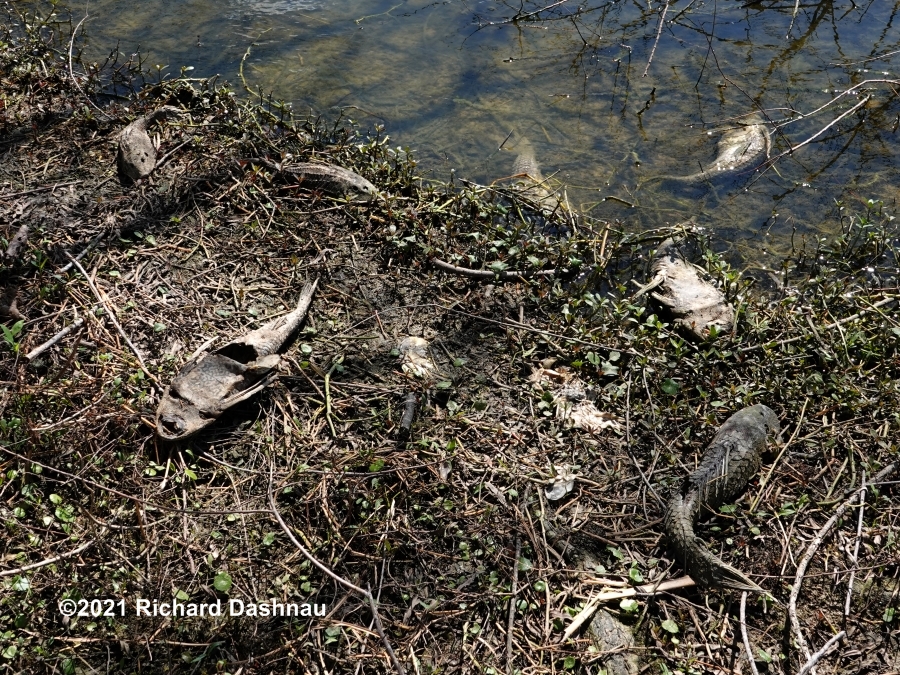
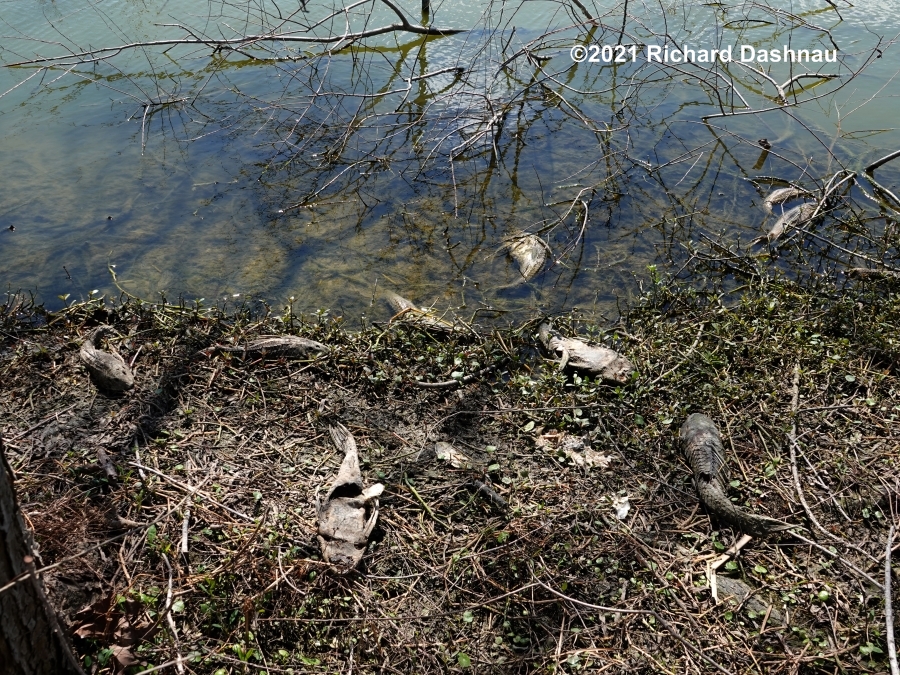

Carcass by my size-11 foot
Black Vultures still picked at
the carcasses.
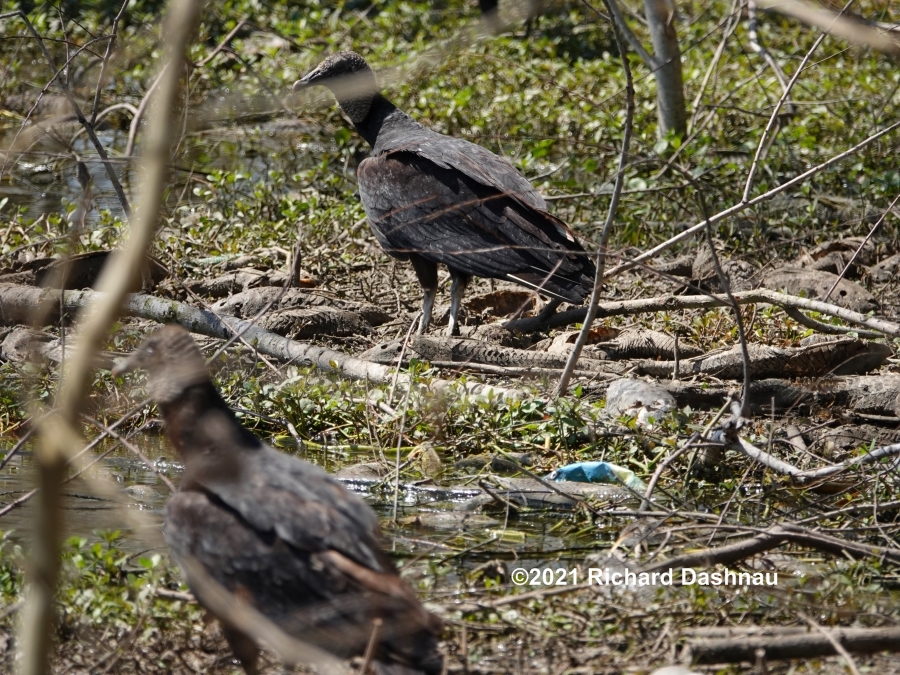

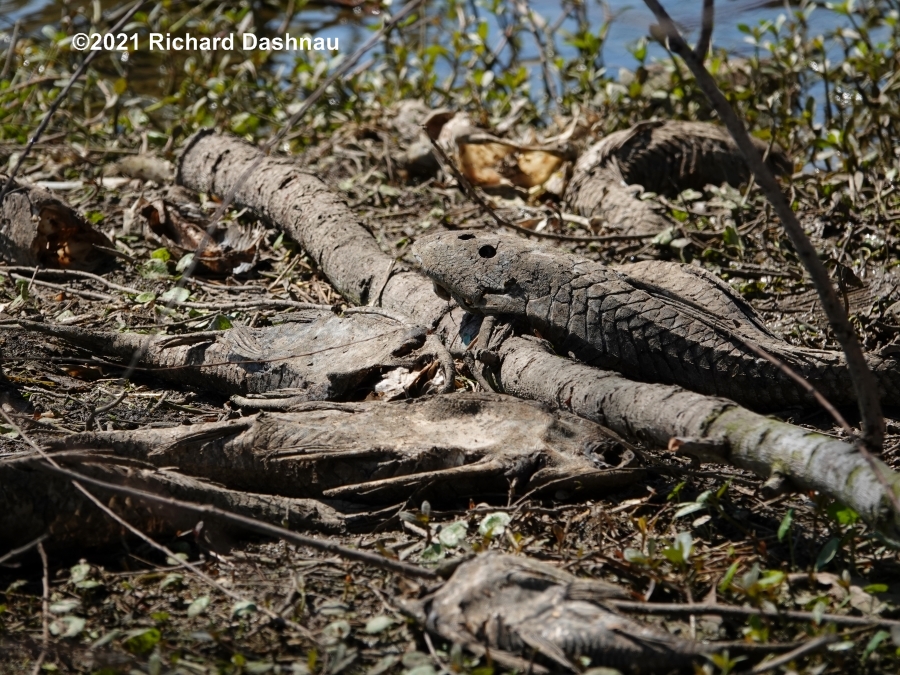
B.Vulture (Coragyps atratus) in a pile.
Closer view of one pile.

Stitched panorama of close view of one pile.



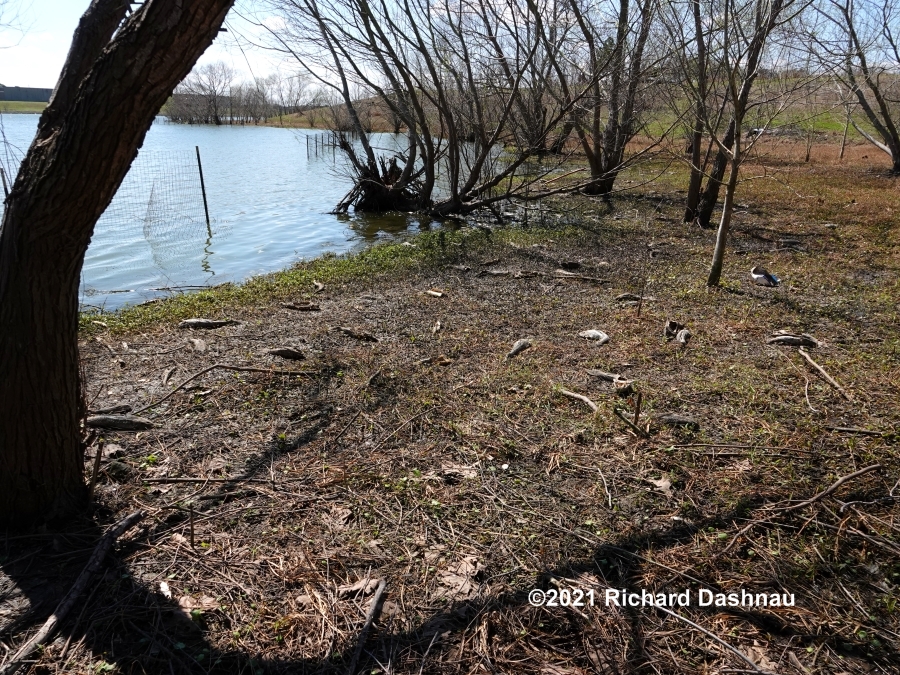
I shot these four progressive views to capture the extend
of the carcass field--and this was just one part of the coverage.
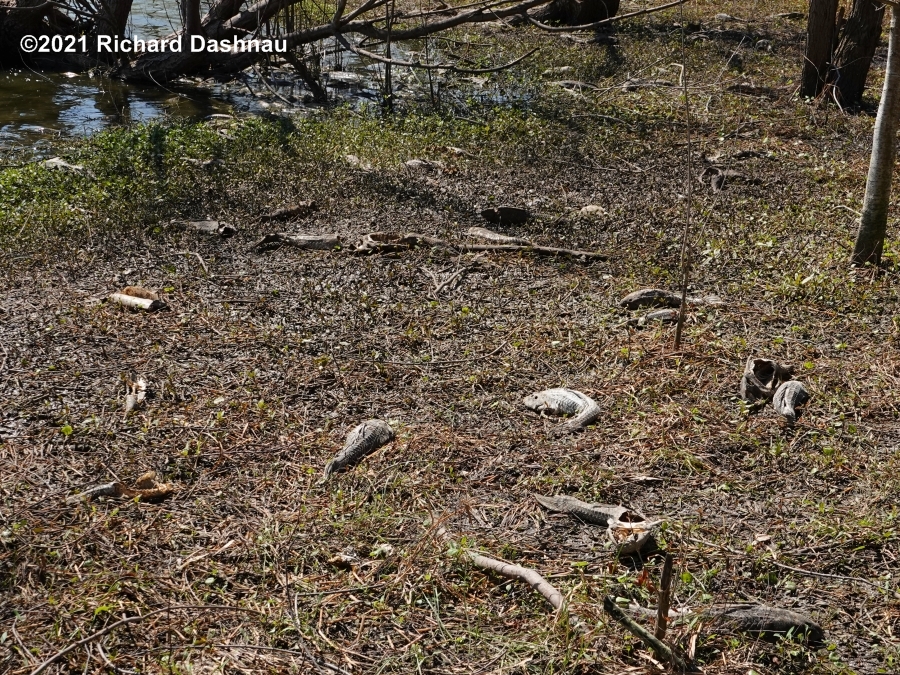

This is a
camera-built panorama just a bit further West. Fish carcasses were
scattered everywhere.
03/04/2021 I
visited Fiorenza Park North again, It's not too far from home. I'm
not sure, but I think the water level has dropped since my last visit.
Today, I discovered that the armored catfish (various species?)
apparently did not come through the freeze even unscathed. There
were many dead ones
scattered around the shoreline. There were many different sizes.
Maybe they had died during the freeze but their carcasses had been
hidden by deeper water.
They
were certainly visible today!

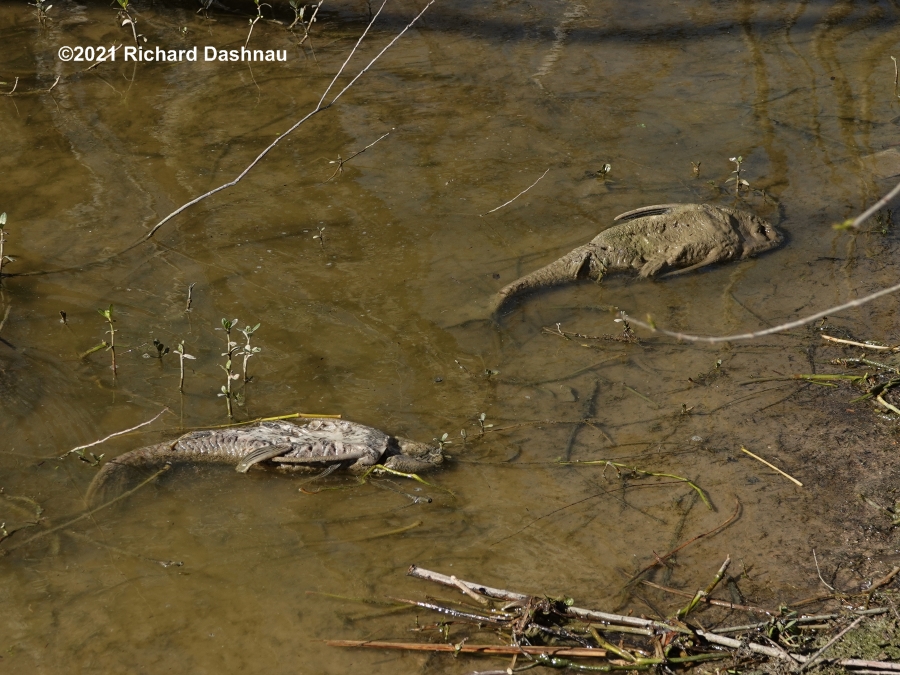

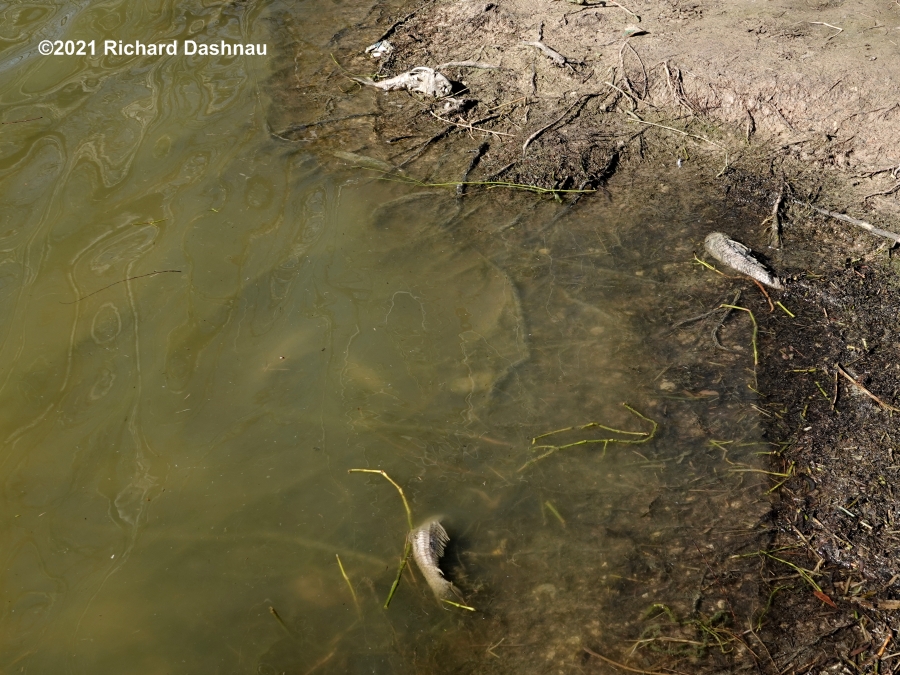
5 in this picture.
Two
of those 5, closer.
At least 10 in this picture.
A
closer view, some are submerged.


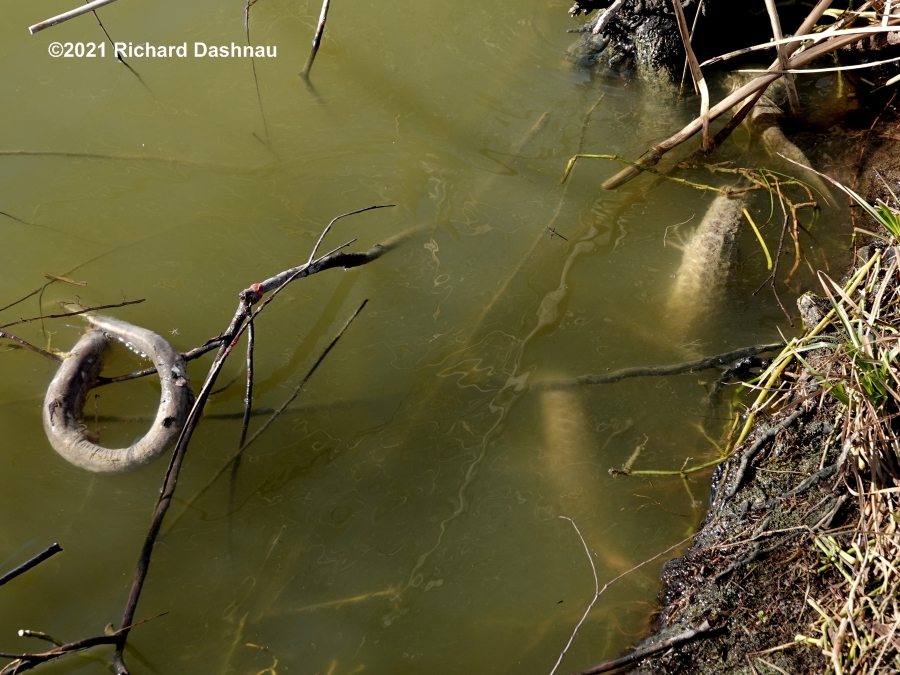
And there are more.
I couldn't
get closer to these big ones. Two more, and something very
interesting!
I noticed the uncommon carcass
floating near the bank. I was able to get it on land, and I took photos
of it. I could think of two "tube-shaped" animals
that it might have been. One is an amphibian, and one is a
reptile. I took my pictures of details that I thought would help me
identify the animal. As the pictures
below will show, the carcass had been partially-eaten, and was also
decomposing. So, what could it be?
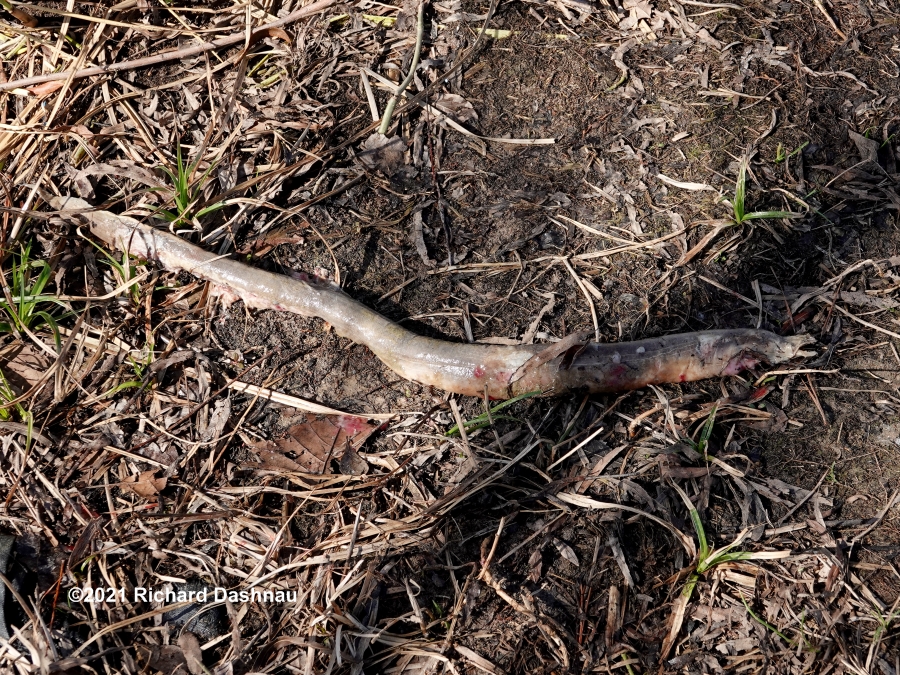



Carcass is in pretty bad shape.
My foot next to the carcass for
scale.
There's a quarter
near the head Here's a look
at the skin. It isn't smoooth.




A
look a bit closer. Are those scales? Pectoral area behind the
head is chewed off The head, no external gills.
Some small teeth show, not hooked.
One
of the animals that have a similar shape is a snake. Let's compare
with some pictures of Diamondback
Watersnakes (Nerodia rhombifer) that I've taken in the past within a few
yards
of where I found this carcass. The carcass has no color
pattern--even if it doesn't match this snake, it doesn't match any
others, either. The scales on the carcass are the wrong size and
shape-
for this snake, and just about any other local snake. Can't see on the
two snake pictures, but the carcass has NO large belly scales. The few
teeth visible in the skull are wrong for a snake, too.
a snakes teeth are thin, sharp like needles, and the tips curve
backwards. I couldn't see any eyes on the carcass, so can't
really compare those. The pictures don't show it well, but the tail
of the carcass was flattened vertically. No local species of snake have
a tail that's flattened so that it pushes well--like an alligator's
tail, or a tadpole.... And that brings up the second animal
that I thought it could possibly be.



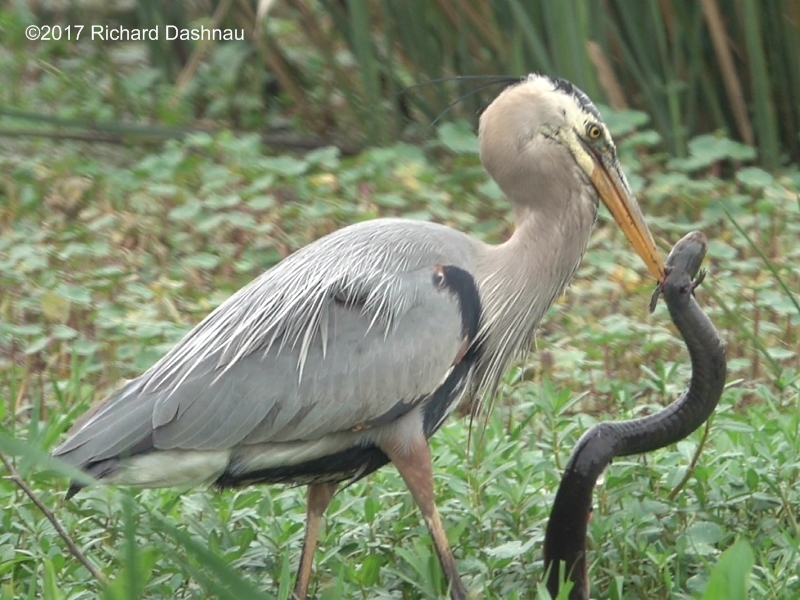
That other animal is an amphibian.
No, not a tadpole. A large salamander that lives in Texas (I've seen
them at Brazos Bend State Park) called a Siren, or usually, a Lesser
Siren. (Siren
intermedia). Sirens can grow to 2 feet long (60.96 cm). There are
two pictures above of one in the jaws of a Great Blue Heron. They do
have a flattened tail. But they are totally smooth, and
they have two small front legs. The carcass doesn't show legs, but they
could have been torn off where that damage is. Sirens also have large,
exposed branching gills on the sides of their
head. There are none here. I really doubt that the carcass was a
Siren, also. So, what does that leave us? How about an
American Eel? I think that this was the carcass of an American Eel
(Anguilla rostrata). They do live here, and I've found at least one
report online of one being caught in Brays Bayou. I've never seen
one in the wild in Texas (or anywhere else).
01/13/2018 and 01/20/2018 . Various
species of the "tropical fish" known as Plecostomus have become
established in Texas waters. They are considered invasive and
destructive. Since they have been living in these waters, it's
reasonable to assume that they have survived winters here.
However, over the last few weeks (specifically
from January 12 to January 20) we've had especially cold
weather. During the first week there were about 4 days of
temperatures around 30 degrees F. And during
the second week we had about 4 days near 20 degrees F. While I
was visiting Archbishop Fiorenza Park on the 13th, I noticed
many dead Plecostomus along the banks
of the lake. On the 20th, most of the carcasses were gone from
where I'd seen them, but I did see Black Vultures eating a
few. I assume that the cold weather killed them.
The pictures of the dead fish are from the 13th. I've taken a
picture of my foot near some of the carcasses for scale (shoe
size 11). The pictures of the vulture
are frame grabs from a short video clip. And the
video is here.
(NOTE 7/19/2020): The fish in
the pictures below are probably Pterygoplichthes species--but
still armored catfish.)





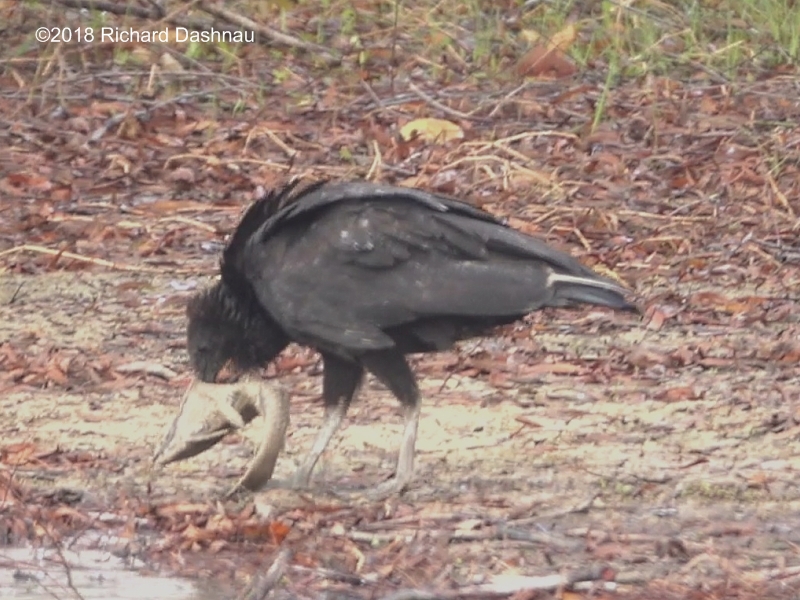


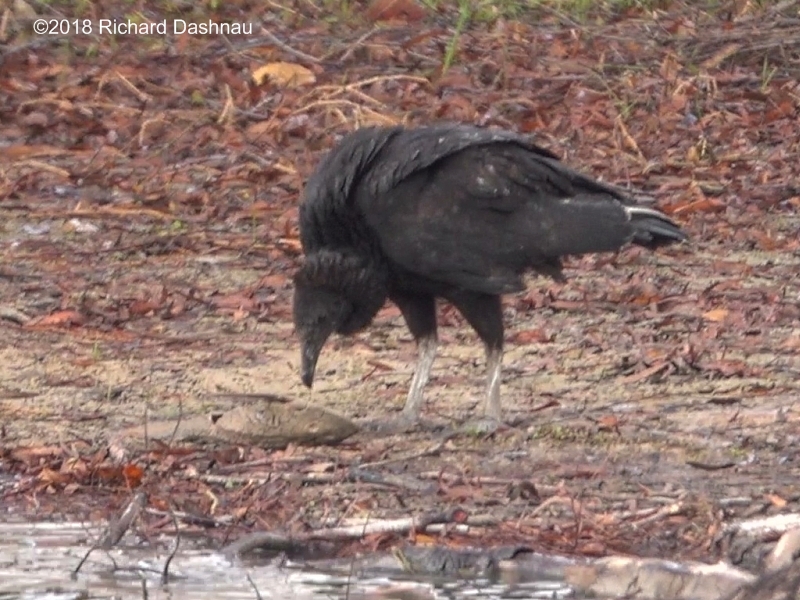
11/9/2015 Since
my investigation of the breaching fish, I've been looking
through older video footage and photos of gar that I've filmed
over the years. I've found a number of video clips
showing gar (mostly Spotted Gar)gulping air. In all the
older material, including the Alligator gar I filmed this year,
the breaching is not as active as it seemed to be in the video
that I shot in
September and October of this year. I've added them to this
page, but put them the chronological order of the rest of the
page. In the slow video, I can see a consistent process which
seems
to take the 3 steps I've also described further down the
page:
1) The end of
the jaws extend out of the water and open briefly (perhaps with
slight opening of gill slits,).
2) The jaws
and head extend further out of the water, and the jaws and gills
slits open at the same time. A large quantity of gas is expelled
from the gills slits, making large bubbles.
3) The
head submerged, the gar begins to sink. The gill slits open, and
a small amount of gas is expelled making a small stream of
bubbles.
At this time,
I don't know exactly what is going on.
09/13/2015--10/11/2015 For some time this summer, fish have been
"hitting" the surface of the water in various parts of the park.
I'd been watching this
activity near the Spillway Trail. There was a lot of fish hitting
the surface in Pilant Slough, from the Spillway west to the
Observation Tower (distance about 900 feet, according to Google
Maps). I had assumed that most of the fish hitting the surface
were Bowfin, and possibly Gar.
I've observed both gar and bowin breathing air at BBSP before, and
at those times, the breaching was relatively sedate.
*These* breaches were violent, sometimes spraying water for a wide
area. And the activity brought many alligators there to hunt the
fish.

I started watching more
closely starting in September, where I determined that the fish
seemed not to be hunting.
However, the water was usually obscured by glare or by murkiness,
so I could not tell what kind of fish were surfacing. I was nearby
when fisherman successfully caught
both bowfin ( Amia Calva) *and* gar (both spotted (Lepisosteus
oculatus) and shortnosed(Lepisosteus platostomus).
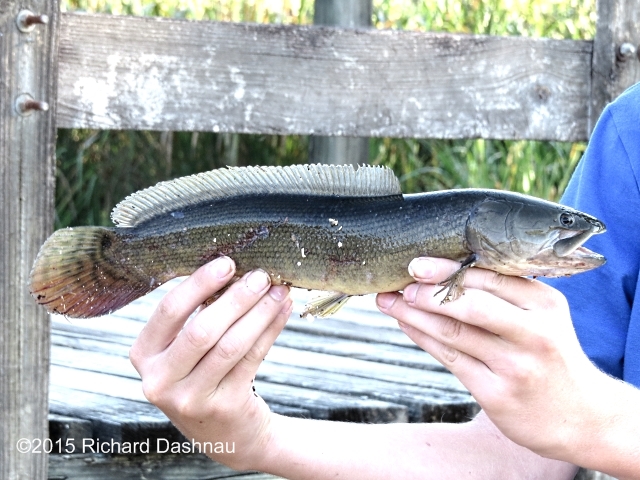
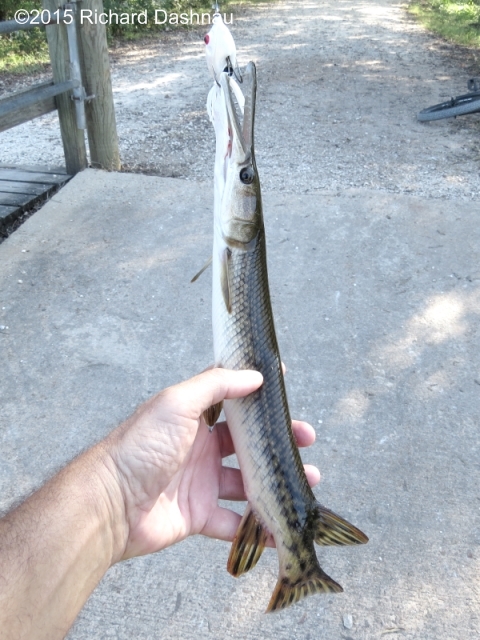
BOWFIN
SHORTNOSE GAR
It seemed likely that these fish were the culprits, but I wanted
to be sure. So, I started trying to capture high-speed video of
the breaching events.
If I could capture an event at 210 frames per second, then I could
play it back slower to identify the fish. This was
a bit difficult, but after 5 weekends (9/13/15 - 10/11/15), I
caught enough video clips to make some identification. I've put
these all together into one 5-minute clip.
I was able to identify bowfin in some of the clips. Most obvious
identity key was the long dorsal fin, but the large blunt head and
small pectoral fins were secondary keys.
Some of the other fish were gar; easily identifiable by the long,
thin snout. The clip is in 2 formats here(wmv) and here (mp4) The animated gifs were
made with frames
from the video.

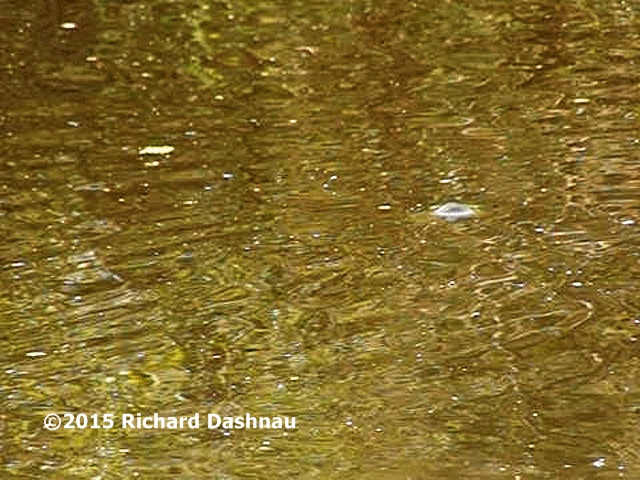

BOWFIN
BOWFIN
PLECOSTOMUS?
But, I saw a fish in a few of the clips that I believe was neither
a gar nor a bowfin. The fish were usually dark, with a rounded
head, but the pectoral and
pelvic fins were very large-much larger than on a bowfin and
closer together than those on a gar. The 3rd gif above shows this
fish.
I believe that these fish are examples of plecostomus! I have
found carcasses of plecostomus near some of our local bodies of
water.
Here's a picture of one that I took near Buffalo Bayou in 2009.



And here is a picture of a live one that I filmed today at a local
pet shop.


From some research online, I have found that "plecostomus" can
refer to anumber of different species of fish. They are also known
to surface periodically to "gulp air",
possibly for bouyancy control. I haven't seen anything that shows
they use the oxygen. Gar and Bowfin are related, and both have
lungs. In some of the literature I've read, these are called
true lungs.
In AIR-BREATHING DURING ACTIVITY IN THE FISHES AMIA CALVA AND
LEPISOSTEUS OCULATUS C. G. FARMER* AND D. C. JACKSON
Accepted 19 January; published on WWW 5 March 1998 it is stated
that lungs appeared in fish *before* swim bladders. (p.943) ;
During low-level exercise, more than 50% of oxygen used by both
species came from the air. Bowfin and Spotted gar.(p. 945)
and on P.947 Increasing temperature increases the rate of
air-breathing in bowfin. Spotted gar also increase air-breathing
with temp.
Air breathing may be more important to support activity than
surviving in hypoxic water. The fish CAN get O2 from air
if there is none in the water, but this situation happens less
than the need driven by activity.
In EFFECTS OF TEMPERATURE AND LIGHT ON AERIAL BREATHING BEHAVIOR
OF THE SPOTTED GAR,LEPISOSTEUS OCULATUS by
GERARDUS C. DE ROTH THE OHIO JOURNAL OF SCIENCE 73(1): 34,
January, 1973.
Freshwater gars gulp air at the surface even at the highest levels
of dissolved Oxygen.Page 38.
In another study, gar were obligate air breathers at oxygen lower
than 4.5 ppm but active gar were obligatory air breathers at
higher oxygen concentrations. So, rising temperatures could
also cause more surface breathing. p39 (By definition water is
hypoxic if it doesn't have enough O2 to support life (<
2ppm) http://toxics.usgs.gov/definitions/hypoxia.html
Normal is 8-10 ppm (parts per million)
November 10, 2002The
image below (BOWFIN) is of an interesting "primitive" fish called
a "Bowfin".
The water at the park got
very high. In fact the nearby Big Creek was so filled that the
water from Pilant Slough, which normally flows out of the park,
was flowing back INTO the park from Big
Creek. As evidence of the amount of water we received, here it the
fishing pier on Hale Lake, the deck of which usually stays at
least 10 feet above water level (see HALE LAKE PIER,
below). This happened for about 2 days, until the water
level dropped in Big Creek . As the water started flowing back out
of Pilant Slough, other bodies of water were free to drain. 40
Acre
lake started flowing back under the footbridge, and a few
predatory fish stationed themselves in the sluggish flow. Among
them were a few Bowfin, and a few Spotted Gar (see image below).
These fish were about 15 inches long. It is interesting to
me that these "primitive" fish both inhabit the park, right along
with various perch, sunfish and bass. Of course, let's not forget
the
Alligator Gar! The image below (HEAD AND SPINE) shows my completed
gar as it is now.
-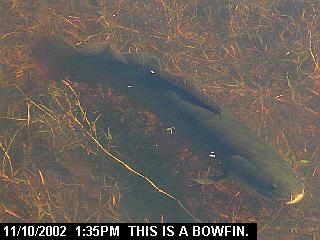 -
- -
- -
-
BOWFIN
SPOTTED
GAR
GAR HEAD AND SPINE
HALE LAKE PIER
Go
back to my home page, Welcome to
rickubis.com
Go
back to the RICKUBISCAM
page.
Go
back to the See
the
World page.
























































